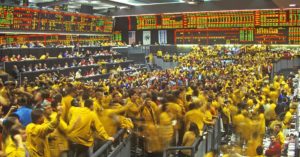 A new working paper from Amy Whitaker and Roman Kräussl suggests a new model of finance for visual artists (described by Isaac Kaplan in Artsy here). The abstract of the paper (free download here) is:
A new working paper from Amy Whitaker and Roman Kräussl suggests a new model of finance for visual artists (described by Isaac Kaplan in Artsy here). The abstract of the paper (free download here) is:
Using unique historical sales data from the Leo Castelli Gallery, we introduce a novel model of evaluating art market returns using first-sale prices alongside auction results. We create a sample portfolio to analyze what would have happened if the artists Jasper Johns and Robert Rauschenberg had retained 10% equity in the work they sold through their dealer in the years 1958 to 1963, which was the start-up phase of the artists’ careers. We find that this retained-equity portfolio would have performed from 2.8 up to 140.8 times better (Rauschenberg) and from 24.9 up to 986.8 times better (Johns) than the S&P 500 over the same period. Modeling equity portfolios for artists changes the fundamental structure of art markets. Because the fractional equity is a property right under the Coase theorem, this system introduces a secondary market for shares in artwork. These shares could trade using a technology such as the blockchain and would allow more democratic and diversifiable access to investment in art markets. Our framework extends to other creative industries in which early-stage work is difficult to value.
To consider their plan, step back and recall the debate over artists’ resale royalty rights, or droit de suite. In that model, artists would receive a share of any profits arising from the resale of one of their works. Aside from the difficulties of administering such a scheme, there is at its heart an economic problem: resale royalty rights would serve to force artists to be investors in their own works. They would receive a lower price at primary sale (since collectors’ reservation prices will fall as a resale royalty right is imposed), with the hope of gaining something in subsequent resale. But for artists this isn’t a very good vehicle for saving: it puts their wealth in a narrow, undiversified portfolio, and essentially forces this saving upon them.
The Whitaker and Kräussl is an improvement over resale royalty rights. It gives artists a partial ownership stake in a work even after sold in the primary market, but unlike resale royalties, it is an asset that can be sold to other investors, in a newly created secondary market. This gives artists a more liquid asset than does the resale royalty, since the artist need not wait for a work to be resold. It would also create a market in shares of paintings that could allow investors to diversify their art portfolios.
But the initial economic problem remains: why would artists want to hold an equity share, rather than get the maximum amount they can in the primary market? It’s a risky move for people whose income stream is already highly uncertain. And so on the benefit to artists, I remain to be convinced.
Would Jasper Johns and Robert Rauschenberg have done well under such a scheme? No doubt! But hindsight has perfect vision here, and it is always the case that artists who turn out to be highly successful regret any future earning streams in their work captured by someone else as a result of the terms of initial sale. If you look at most lawsuits between artists, musicians, actors and producers, the most famous ones have been about successful artists who regret taking a fixed payment in lieu of (uncertain) future shares of receipts: the artists bet on the wrong side, and regret their bet. But it’s a distorted way to think about the market for all artists, all musicians, where the majority of whom will do best under a scheme where they are paid as much up front as possible, and someone else bears the risks in the nobody-knows-anything world of the arts – there is a survivorship bias in analysing market alternatives based on the careers of the most successful.
Whitaker and Kräussl write:
Applications of this research into practice involve partnership with artists and dealers to develop retained equity systems within the arts, on a pilot and a systemic basis. Testing the applications in the art market can inform the development of this kind of thinking about structural ways of compensating the makers of early-stage creative work. As a gig economy and “uber-ization” of work spreads and more workers are asked to be free agents, this kind of equity model allows project-based workers to bet on (invest in) the future outcomes they help to create. It is possible that over time the very idea of being paid only by wage and not by equity could become outmoded.
It’s an interesting possibility to be sure, but I’m not sure this is a bet most project-based workers will want to take.

Leave a Reply